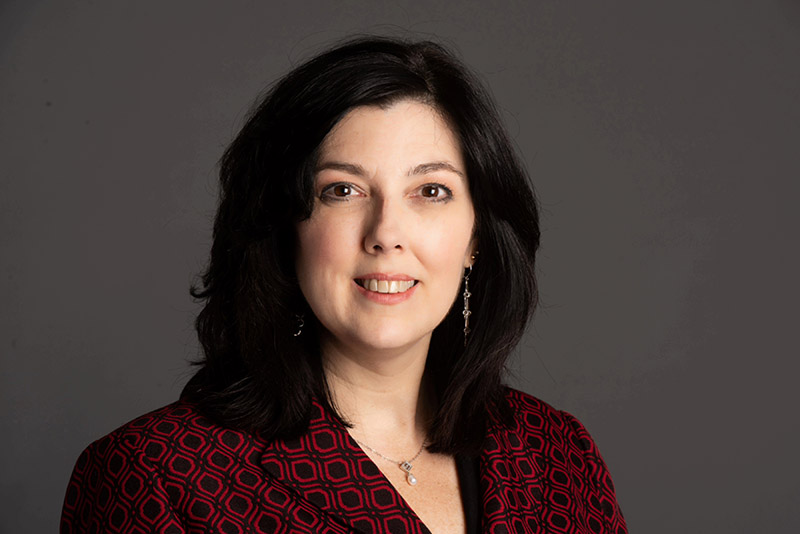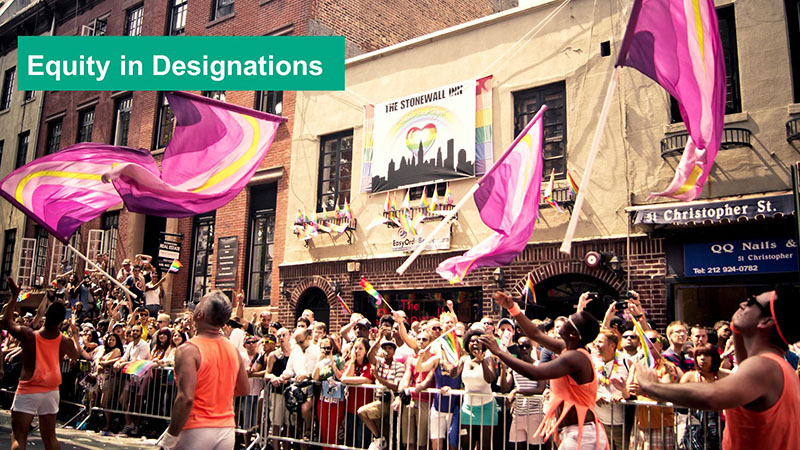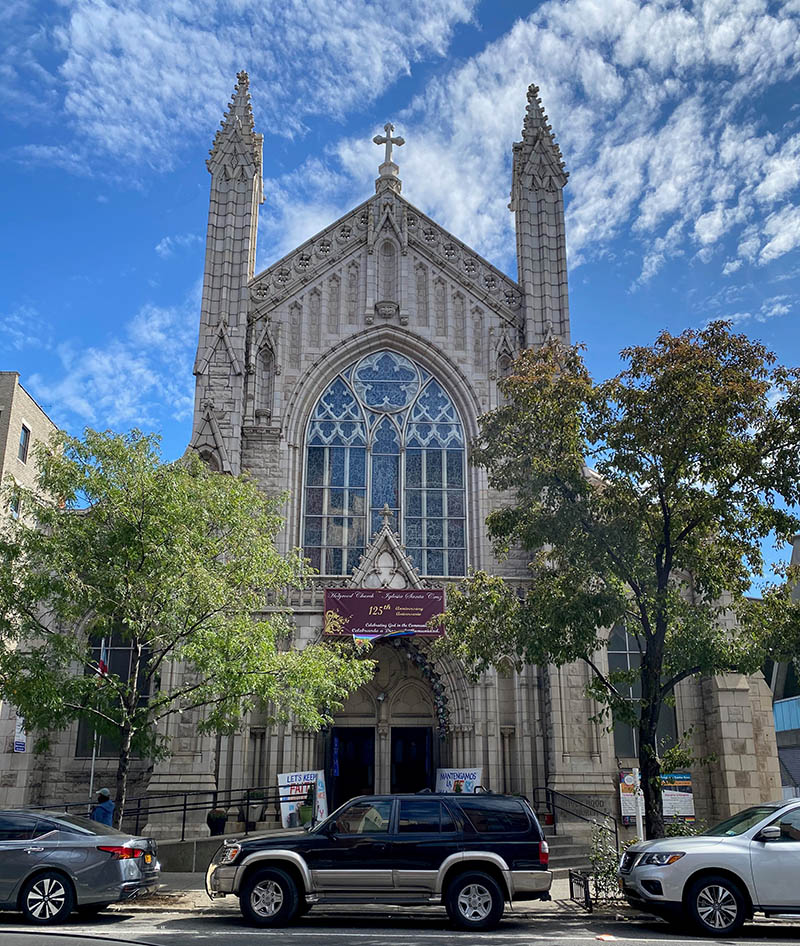|
NYC Landmarks Preservation Commission
|
Special Issue - February 2021 |
|
|
|
|
|
|
 |
|
In January, LPC launched an Equity Framework, which I want to share with you along with recent work that fits in that framework, including recent designations and releasing an interactive story map called Preserving Significant Places of Black History. Addressing equity in every aspect of LPC's work has been my priority throughout my tenure, and because of the events of this past year, I felt that it was important for the LPC to publicly reaffirm our commitment to equity by creating a framework to guide the agency's priorities this year and into the future. This includes enhancing transparency and accessibility in our regulatory and outreach work, and prioritizing designations that represent New York City's diversity and designations in areas less represented by landmarks. Recent designations reflect that prioritization, including, Conference House Park Archaeological Site, which would be the city's first landmark recognizing the many generations of Native Americans who lived in the area; Holyrood Episcopal Church-Iglesia Santa Cruz, which fills a gap in representation of New York City's Latino community; 70 Fifth Avenue, significant as the former home of the national office of the NAACP in the early-20th century, as well as many progressive organizations that advanced social justice and equality; and the Dorrance Brooks Square Historic District in Harlem and the New York Public Library, Harlem Branch, which both recognize the contributions of African Americans during the Harlem Renaissance.
In recognition of Black History Month, we launched our story map Preserving Significant Places of Black History, to provide greater accessibility to landmarks and historic districts that reflect the contributions and achievements of African Americans, and illustrate that the fight for racial equity and social justice is as relevant today as it has been over the course of the City's history.
Wishing you all the best,
Sarah Carroll
|
|
|
|
|
LPC Launches Equity Framework |
|
|
|
|
 |
|
On January 19, 2021, LPC launched an equity framework that will guide agency priorities this year. As part of LPC’s equity framework, the agency will prioritize designations that represent New York City’s diversity and designations in areas less represented by landmarks, ensure effective outreach both in its regulatory work and in garnering support for designation; and enhance transparency and accessibility in its regulatory work.
Much of the framework is related to LPC’s research department and designations. Historic buildings embody the stories and experiences of people, and thoughtful exploration of historical context in designations can expand public recognition and equitable representation of New York City’s diverse history. After studying the Commission’s designations to date we have developed a set of priorities to ensure a more equitable representation of our city’s diverse history through our designations. We are particularly focusing on communities whose stories and experiences have not yet adequately been told. The equity framework commits to prioritizing designations that reflect the city’s diversity, and in areas less represented by landmarks; address difficult and contested histories, emphasizing the fight for social justice and civil rights; undertake Inclusive research and seek to tell the stories of all New Yorkers.
You can watch the presentation made to the Commission or read more the framework in more detail about it here.
|
|
|
|
|
New Story Map Celebrates NYC’s African American History through Landmarks and Historic Districts |
|
|
|
|
On February 9, 2021, LPC released an interactive story map called Preserving Significant Places of Black History to celebrate New York City’s African American history through designated landmarks and historic districts. LPC’s story map is the result of a careful study of places important to African American history that have been designated since the Commission was created in 1965. It highlights 75 individual landmarks and 33 historic districts throughout the city, designated in recognition of their associations with New York City’s Black history from before the Civil War through the Civil Rights Movement, designated properties where more recent scholarship post-designation has revealed important connections, and historic districts located within historically African American neighborhoods as defined by census records over the past 50 years, totaling over 10,500 buildings and sites. Read more about it here.
|
|
|
|
|
Proposed Landmarks Reflect LPC’s Equity Framework |
|
|
|
|
 |
On February 2, 2021, the Commission unanimously voted to calendar the Dorrance Brooks Square Historic District and the New York Public Library, Harlem Branch at -9 West 124th Street. Both recognize the contributions of African Americans during the Harlem Renaissance.
The proposed Dorrance Brooks Square Historic District consists of intact streetscapes of a striking variety of 19th and early-20th century row houses, multi-family dwellings, and institutions, designed by prominent New York City architects within two sections on either side of Frederick Douglass Boulevard between West 136th Street and West 140th Street.
The Harlem Branch of the NY Public Library is an elegant Classical Revival style building designed by the prominent architectural firm of McKim, Mead & White in 1907 and opened in 1909, one of twelve Carnegie libraries designed by the firm for the New York Public Library.
On January 19, 2021, the Commission unanimously voted to calendar Conference House Park Archaeological Site at 298 Satterlee Street on Staten Island, Holyrood Episcopal Church-Iglesia Santa Cruz at 715 West 179th Street in Washington Heights, and 70 Fifth Avenue, known as the Educational Building, in the Greenwich Village.
The Conference House Park Archaeological Site recognizes the over-8,000-year history of Native American occupation of the site and would protect its below-ground archaeological resources. It would be the city’s first Landmark to recognize its thousands of years of Native American habitation.
Holyrood Episcopal Church is architecturally significant as a sophisticated and well-executed Gothic Revival design by the architectural firm of Bannister & Schell, and is culturally significant as an important social, cultural, and religious anchor for the Latino/a community for the past 40 years.
70 Fifth Avenue, a Neoclassical/Beaux Arts building designed by Charles A. Rich, is significant for housing the national office of the National Association for the Advancement of Colored People (NAACP) among a remarkable tenant roster of progressive organizations that have shaped American society.
|
|
|
|
|
Downtown Brooklyn Home of Prominent Abolitionists is Designated |
|
|
|
|
On February 2, 2021, the Commission unanimously voted to designate the Harriet and Thomas Truesdell House at 227 Duffield Street in Brooklyn as an individual landmark. This Greek-Revival style former row house is a rare surviving 19th-century abolitionists’ home in Downtown Brooklyn. For more than a decade prior to the Civil War, 227 Duffield Street was the home of Thomas and Harriett Truesdell, who had been active in abolitionist work in Rhode Island before continuing to support the movement in Brooklyn, a hub for abolitionist activity in the early 19th century due to its active waterfront and large population of free African Americans. Read more about it here.
|
|
|
|
This is the NYC.gov news you requested for:
Landmarks Preservation Commission News
Unsubscribe | Preferences | Comments
PLEASE DO NOT REPLY TO THIS MESSAGE!
|
|
|
|